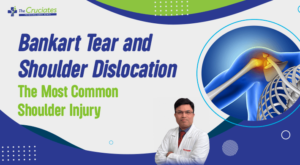Dr. Nagendra Prasad
Your shoulder may be the largest ball-and-socket joint in your body, but that doesn’t mean it can’t experience some of the most common and complex sports injuries around. Injuries to the shoulder joint are very common, especially among young athletes who play contact sports such as soccer or hockey. A shoulder dislocation occurs when the head of the upper arm bone (the humerus) comes out of the socket on the shoulder blade where it normally resides. There are several types of shoulder injuries, including impingement syndrome and labrum tears, but by far the most common cause of shoulder pain in young people between 15 and 30 years old is what’s called a Bankart tear or shoulder dislocation
What is a Shoulder Dislocation?
The shoulder joint is a ball and socket type of joint. This is formed by the head of the humerus, which is the ball of the joint, and the glenoid cavity, which is the socket of the joint. It is one of the most mobile joints in the human body. This hypermobility makes the shoulder joint the most unstable joint of the body.
A shoulder dislocation is when the head of the upper arm bone comes out of the socket of the shoulder blade. This can be classified as either an anterior or posterior shoulder dislocation. When this happens, it leaves the arm bone loose and is susceptible to additional dislocations.
Anterior shoulder dislocations are more common than posterior shoulder dislocations. It occurs due to anteriorly directed force on the arm when the shoulder is abducted and externally rotated.
What is a Bankart Tear?
Bankart tear is an avulsion of the anterior labrum and anterior band of the IGHL from anterior inferior glenoid. It is a type of traumatic labral tear. It is most common in people aged 20 and younger, with 90% chance for recurrence in those under 20. Younger the age more the chances of recurrent dislocations. This is most common type of injury. The Bankart’s lesion is seen in 87–100% of initial dislocation.
Sometimes, Bankart tear may be associated with fracture of the adjacent anteroinferior glenoid. This is known as Bony bankart.
How do these two conditions relate to each other?
The glenoid labrum acts as a chock-block or wedge to prevent the humeral head from rolling off the glenoid and acts as a static stabilizer through a buttress effect. A bankart tear occurs as a result of shoulder dislocation. When the shoulder dislocates, the ligament and labrum that holds the ball of the humerus in place may be torn. The most common age group for this injury is teenagers, especially those who are active in sports and has 90% chance for recurrence at age <20. Younger the age more the chances of recurrent dislocations.
What are the symptoms of Bankart Tear?
The patient gives a history of the traumatic events causing dislocation
Feeling of instability – sometimes patient feels their shoulder is loose, old cases may have a history of shoulder dislocation during sleep
Shoulder pain – caused by subluxation and excessive translation of the humeral head on the glenoid

The patient hesitates to abduct and external rotate the shoulder. This is because the humeral head travels through a weak point in the shoulder and may dislocate.
Patient with recurrent subluxation describes a sudden catch, followed by a sudden inability to move the arm with a “numb” feeling the so-called “dead arm syndrome”.
Most patients are athletic adolescents or young adults with joint laxity. Such individuals may have pain with overhead movements due to an inability to control their laxity by means of their muscles.
The most common presenting complaint is pain. Loss of internal rotation in young patients may be an important finding suggestive of posterior capsular contracture that is often associated with subtle instability.
TREATMENT
- Nonoperative
Acute reduction, ± immobilization, followed by physiotherapy
It is done as immediate management if patient comes with dislocated shoulder and done as emergency OPD procedure. Studies have not shown any benefit of immobilization of more than 1 week for decreasing recurrence rates.
- Operative
Indications
First-time traumatic shoulder dislocation with Bankart lesion confirmed by MRI in athlete younger than 25 years of age.
High-demand athletes.
recurrent dislocation/subluxation (> one dislocation) following nonoperative management with less than 20-25% glenoid bone loss.
Arthroscopic bankart repair is the most common treatment for shoulder dislocation. During this procedure, your surgeon will make a small incision on the front of your shoulder to get a better look at the damage. They’ll then insert a small camera into the incision to see inside your shoulder joint. Your surgeon will use instruments to move your bones back in place and tighten any damaged labrum before closing up the incision with stitches or surgical staples. This procedure typically takes about 30 minutes.

